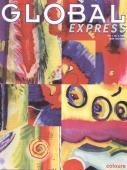 |
It felt far away from Paris and the busy life I was leading there. Standing on the wooden balcony outside our room I gazed across the extraordinary view before me. About a hundred single storey houses made of mud and straw lay scattered over a flat plain encircled by mountains. A shallow river meandered its way through fresh green scrubland. Close to the town llamas grazed peacefully, attended by a solitary figure in bright skirts and a bowler hat. At the top of the town stood a whitewashed church with a thickly thatched roof, it's tiny belfry perhaps the only noisemaker around. The sun was on its way down and soon the generator would be kicking in to provide the two hours of electricity available each day to the inhabitants of San Juan. We had rolled into this quiet town a little earlier--six of us in a 4x4 Toyota Landcruiser--after driving through a wilderness of spectacular beauty. More than 4000m above sea level on the Bolivian Altiplano, in the previous two days we had seen desert, a snowcapped volcano, lakes of white, green and red, hot springs and a canyon. We were in a state of maximum awe and wonder.
Our welcome in San Juan had been typically South American. The gates of our hostel were thrown open to reveal warm smiles of openness and sincerity, the whole family out to greet us. These faces revealed the traces of a hard life focused on survival, but also of an enduring sense of peace. Absent were the familiar lines of stress and worry to which we are so accustomed in our supposedly advanced Western society. One sensed that these people were at peace with their surroundings and with their lives. They had no TVs and few cars. Although at first glance the town with its single dirt road seemed cut off from the world, perhaps the people of San Juan were more in touch with their world than we had ever been. As I stood on that balcony I was filled with the peace exuded by the people and the place, and I realised both how rare and how important a feeling it is for me. Nature is a powerfully spiritual force. What struck me was the profound harmony in which human beings and nature exist. South America was a chance to experience the immense beauty of the world and also its diversity, a chance to see the world in a different way.
In Patagonia it was the vastness of the landscape which struck me. We spent hours, whole days on buses travelling along endless straight roads, across vast plains of yellow and orange grass rimmed by distant blue mountains. But what I saw was only the beginning of what was really there. We saw a glacier 14km in length, a massive and powerful work of nature, moving ice, alive. You could hear it. It was beyond comprehension, and yet seeing these things one could begin to touch the incredible beauty and mystery of creation.
In Peru I encountered history and the legacy of a great civilisation. The Incas, who at one time held sway over an area covering what is now Ecuador, Bolivia, Peru and parts of Chile and Argentina, left an inspiring mark on the land. The remarkable terracing and irrigation systems have completely redefined Peru's difficult terrain, and they remain integral and active components of today's agricultural industry, 500 years after the collapse of the empire. You might think that the many Inca temples and palaces have been well-preserved, but in fact they were just well-built. In Cusco, the Spanish were forced to build on top of existing Inca constructions because they were simply unable to destroy them.
Machu Picchu was saved for another reason: the Spanish never found it. On hearing that the European invaders were destroying everything in their path, the Inca ordered the murder of all those who knew of the existence of this unfinished but sacred city. On learning of this I was both appalled and very moved. I felt sick for the destruction and waste of life, but also for the destruction and waste of a people which followed. It is a mark of the quality of the Inca people that some still live according to their culture and traditions. On the Isla Del Sol on Lake Titicaca, the birthplace of the Inca civilisation, daily life has hardly changed for centuries. The same terraces, the same boats, the same kinds of houses are used. Maize is grown in small, non-commercial plots and the women wash their clothes in the same river. As I wandered along ancient paths I thought to myself--if it's still here, then it must work. And then Machu Picchu. There can be few human creations more breathtaking, more spiritually inspiring or more perfectly balanced in their surroundings. It would have been the sacred jewel of the Inca Empire. Yet today, even unfinished, it still brings us closer to something greater, to a time and a consciousness which sought to harmonise humanity, the earth and the beyond. Machu Picchu is a window into that consciousness from which there is still much to learn. There is more to this world than we can ever realise, but so much of it is there to see when you take the chance and allow yourself to be amazed.
Peter Jones, UK
|













